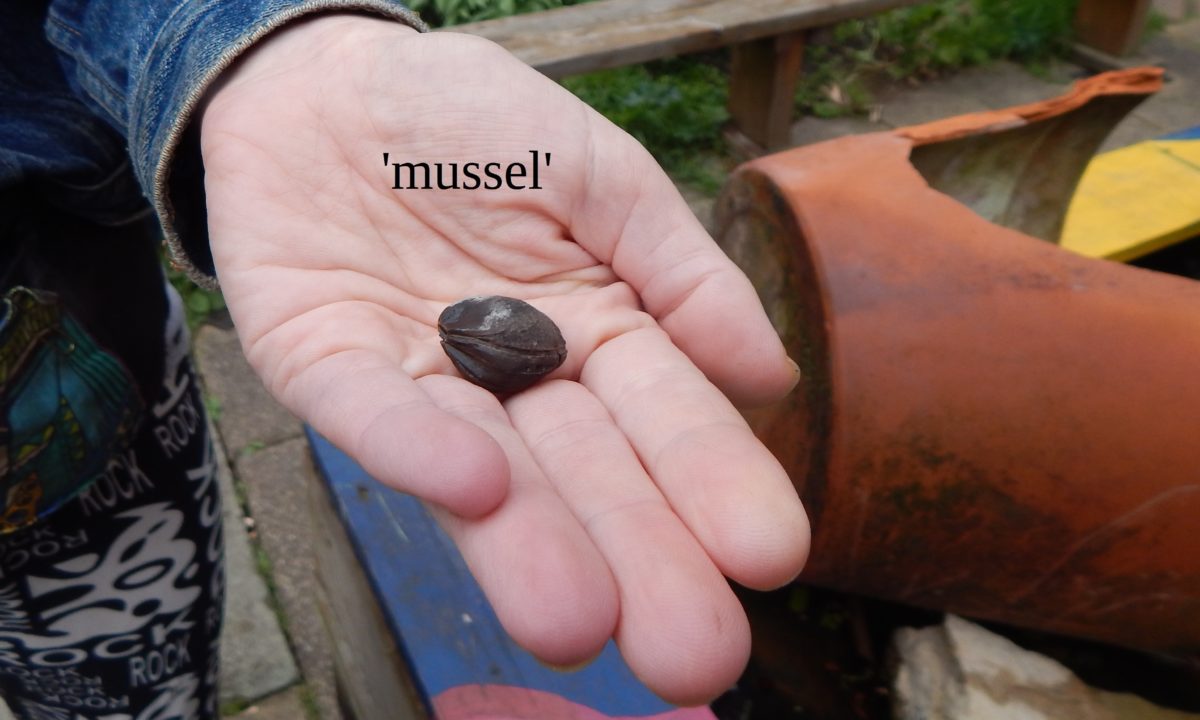The pond has been taking our attention over the past week. The tadpoles are eating the remnants of their jelly. There are black masses of them, so thick, you can hardly see the individuals but for the wriggling of the mass. All the tadpoles are out of the jelly, and eating like crazy. There are unfertilised eggs remaining, but they will be eaten too.
The day after Easter Monday yields a startling find. I was told, coming in, that we had a mussel in the pond. An utter surprise, how was that possible, where had it come from? I went to the pond, and examined the mussel. Mussels are bivalves, which means the living mussel is enclosed by two identical shells. And this was definitely a bivalve. It was bluish black, like a squashed sphere, about 1 ½ centimetres in diameter. Quite a mystery. An egg perhaps had come in with a plant we had put in.
Back home, I looked up freshwater mussels. And what we had was like no other freshwater mussel. Most were much larger and quite different shapes, many shaped like the traditional marine mussel. Could it be a juvenile? But what was it doing on the surface, they are mostly found in the mud, or stuck on rocks. They have a siphon which takes in water for food and oxygen. This one had a hole, but it seemed a pretty poor siphon.
My daughter Lia was curious too. And the next day we went in the garden together. She had a good look at the mussel, which remained in the pond where we had left it the day before. And she said, after picking it up and examining it closely, ‘I think it’s a nut.’
That instantly hit home. Of course, of course, that’s why it didn’t fit what I had seen in nature books and on line. And I realised what it was. I went to the long, thin plant bed at the back of the pond, and in a very short time came up with another ‘mussel’. It was a plum kernel off the overhanging plum tree. In water, the kernel turned blackish so looked more like a mussel. It is symmetrical, with two halves, so could be thought to be a bivalve.
I wonder what we might still be thinking if my daughter hadn’t said, it’s a nut. Perhaps it would have eventually put out a shoot to confound our ignorance. The moral is that if something is unlikely, be sceptical. The mussel that wasn’t left some saddened by the loss of this exotica, with others amused at what we had come to believe for a couple of days.
But something else was going on in the pond, beyond tadpoles and mussels. It has gone a murky green. So green and murky, you could not see into the depths. Obviously, an explosion of algae. But what has brought it about? In its eight year life our pond has always been clear. This was dreadful, like one of those koi pond, that is so murky, you can barely see the fish within. Ours is a wildlife pond, we want to see the wildlife in it: the backswimmers, developing tadpoles, newts, and underwater plants. But much of this was now invisible in the green murk.
The algae growth has been caused by nitrates in the water. But where had they come from? My belief is that pond dipping is the cause. The dipping stirs up the mud at the bottom which contains nitrate compounds from: frog faeces, newt and snail waste, and from other pond animals, as well as from rotted plant matter.
My singling out pond dipping is disputed by others. I can’t prove it was pond dipping that circulated the nitrates, but I have not heard any other convincing explanation. Either way, we have a distressingly, murky pond. We will have the tadpoles all over the pond soon, but we won’t be able to see them, except in the shallows. My fear is that a lot of our aerators, namely the hornwort and elodia, will die off as the deep green blocks off light.
We need to consider if there is anything we can do to clarify the pond water. There are companies offering chemicals they swear will work, but I am sure they will kill more than the algae. We will not go down the chemical route. Always a good start is to research what others with the same problem have done.

